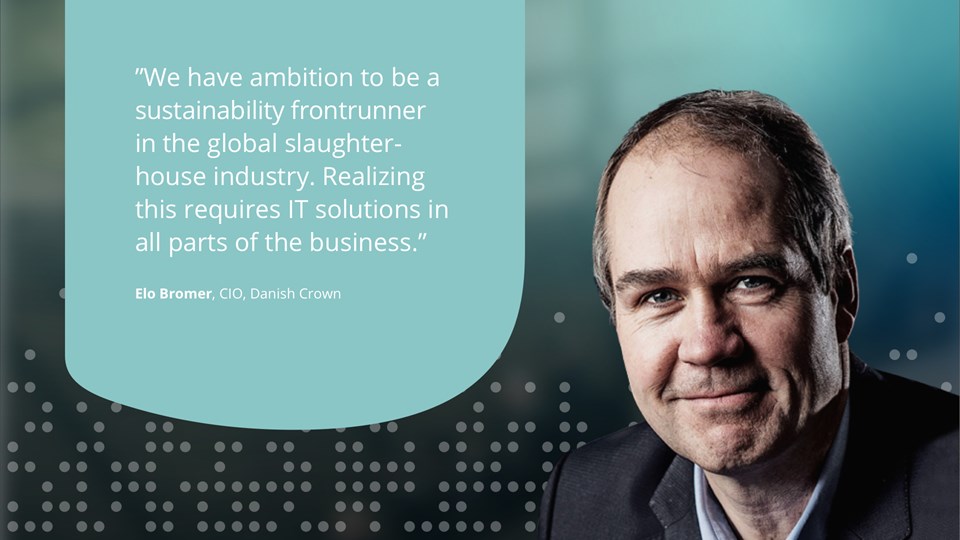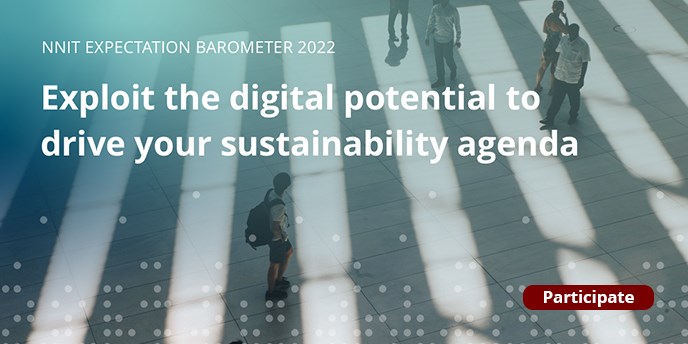Data and automation are key elements of Danish Crown’s efforts to streamline production and make it more climate-friendly. With an ambitious strategy for sustainable transition, the company wants to reduce its climate impact and differentiate itself on the global market.
Do as Elo Bromer from Danish Crown and participate in NNIT’s Expectation Barometer 2022 about IT, digitalization and sustainability.
Eating meat is a recurring theme in the public debate. Danish Crown believes that bringing more nuance to the debate on meat and the climate is important. How meat is produced can vary enormously, meaning big differences in the size of climate impact. That’s why the focus of Danish Crown’s 2026 strategy, Feeding the Future, is on making meat production more climate-friendly.
– Our ambition is to be the frontrunner within sustainability. We want to be best-in-class within the global meat production industry and realizing this requires IT solutions in all parts of the business, says the CIO of Danish Crown, Elo Bromer.
That awareness is also evident in the senior management:
– From the highest level and throughout the entire organization, we’re putting considerable focus on IT and a willingness to invest. A major shift has occurred from when IT was primarily used in administrative industries such as banks as the core of their production machinery. IT is now found in all corners of food production such as ours, which were not historically IT-driven. IT support has become key from administration to production and logistics, continues Bromer.
Sustainable pigs equals competitive advantage
The ambition of being the leader within sustainable food production naturally also serves a strategic purpose for Danish Crown:
– We believe that if we are going to stay relevant, we need to climb up the value chain. It’s not just the product that’s important here, but the value created around it. And this is where more sustainable production becomes very important. On our home market, we have an excellent foundation to build on, because we are so close to farmers. Working with them, we can raise the bar to a totally new level.
That opens doors to some of the big international customers, who set high standards for sustainability, which we’ll be able to live up to. This is very much a parameter we will be judged upon. Not all markets are equally interested in sustainability at this time. But we do believe it’s coming. It’s the way forward for us, and IT will be there to drive us, states Bromer.
Data as the driving force
Data is a central IT focus area at Danish Crown. The key to becoming a more sustainable meat producer is data.
Danish Crown has set itself up to fulfil all three ‘scopes’ in the Science Based Targets initiative. The idea is to ensure that all sustainability measures are driven by knowledge and data, and can be documented all the way to the outermost production link.
– We have measurement points in all corners of our ERP system, and an enormous amount of data to collect and process to be able to compose the complete picture of where we are, so we can act accordingly. How much CO2 do we emit on the farms, how many pigs do we produce, how much water do we use, and how many occupational accidents occur amongst our workforce? These are just some of our measurement points, explains Bromer.
The organization has therefore set out a clear data strategy to provide direction:
– It’s important that we continuously ensure that we are working strategically with our data. How can we create transparency, visibility and measure effect? We gather data all the way from the farmers, and we want to ensure that we use the knowledge we gain optimally and strategically correctly for the business.
Face recognition for hams
Danish Crown has recently announced massive investments in robot technology. An important element of its business strategy is to streamline and automate at every level of its production.
– The problem with a piece of meat is that it’s not a rigid object, such as a box, and you have to pull, fix and rotate it as it passes through production. This is a complex problem that makes heavy demands of technology that will have to be specifically developed, points out Bromer.
– On the IT side, we’re currently working with visualization technologies. We recently tried recognizing hams using face recognition technology. The different parts of the pig have to be processed differently, and if you can automatically recognize the different cuts, you know how they need to be processed. We hit a recognition level of 97%, claims Bromer.
He goes on to add that the same technology can be used to spot follicles, so that they can be filtered out of the line.
– The technology gives us so many options that it becomes a question of using them in the best way possible, and getting them to work in practice. We use ‘innovation groups’, in which the technical and the IT departments are represented to work directly on implementation, says Bromer.
Virtual goodwill
In common with many other businesses, the pandemic accelerated Danish Crown’s digitalization journey.
– We’ve generally become a lot better at virtual working in all its combinations. Whether using virtual reality goggles in production facilities, or holding a conference via Teams, we’ve come a long way. It also concerns the way we work, as we’re working from home to a much greater degree than ever before. It differs from team to team of course, but in principle, if it’s possible, employees work 1-2 days a week from home.
Only three years ago, we would have asked ‘is that possible?’, but we now accept that it is. Technologically, the options are wide open, and it’s up to the management to find the balance and exploit what’s possible in the best way, concludes Bromer.
Elo Bromer’s best tips for CIOs in 2022
1. Ensure you’ve got full backing. IT plays a key role in driving the sustainability agenda, but you must be able to understand the business to be able to support and develop it with IT. Team-orientation is what’s needed. The IT and commercial teams need to work closely together, with a common vision.
2. Set targets and take the right steps at the right speed. Make sure you have full backup, no point in racing forwards if no one’s with you. Combine agile teams with traditional methods wherever it makes sense for the business.
3. Formulate a clear data strategy. How can you obtain the right knowledge, exploit it fully, and how can you make it available to the business as a whole? There’s massive potential in data right now, and data can be gathered on everything. Just because you can gather data, does not necessarily mean you can use it. You have to start where the most value will be created.
Digital facts about Danish Crown:
• In its role as a commodities supplier, Danish Crown expects data to become more value-creating in itself. Because a food manufacturer has to supply a physical core product, digitalization opens new channels and partnerships in which the business can make its data available with the ultimate aim of creating even better user experience.
• Danish Crown’s CIO Elo Bromer predicts that tracking and blockchain will figure prominently when a product’s sustainability has to be proven to conscientious consumers. It will be a fusion of data when, by scanning a packet of bacon in the supermarket, the consumer can get the whole story of where the pig came from and how the product was produced.
Want more?
Would you like to read other CIO interviews like this? And do you want to participate in NNIT’s Expectation Barometer 2022 like Elo Bromer from Danish Crown did?
Participate in our survey and get:
• Knowledge about how well you utilize IT and digital solution to accelerate sustainability
• The opportunity to benchmark yourself against selected digital leaders
• Access to six other ”behind the scenes” cases with digital leaders in Orifarm, Arla, AJ Vaccines, Lundbeck, Danish Crown, Lundbeck and COWI
• Inspiration and tips from selected NNIT experts on how to advance your sustainability goals through IT and technology.
Participate here


